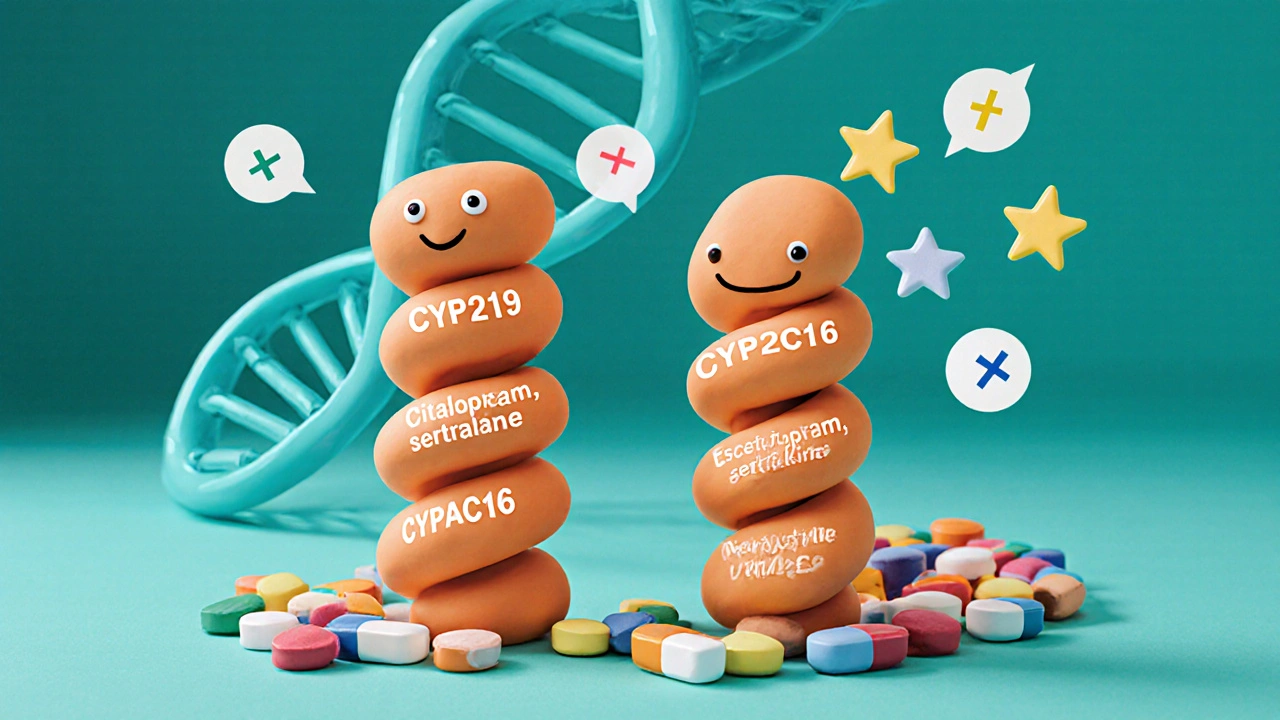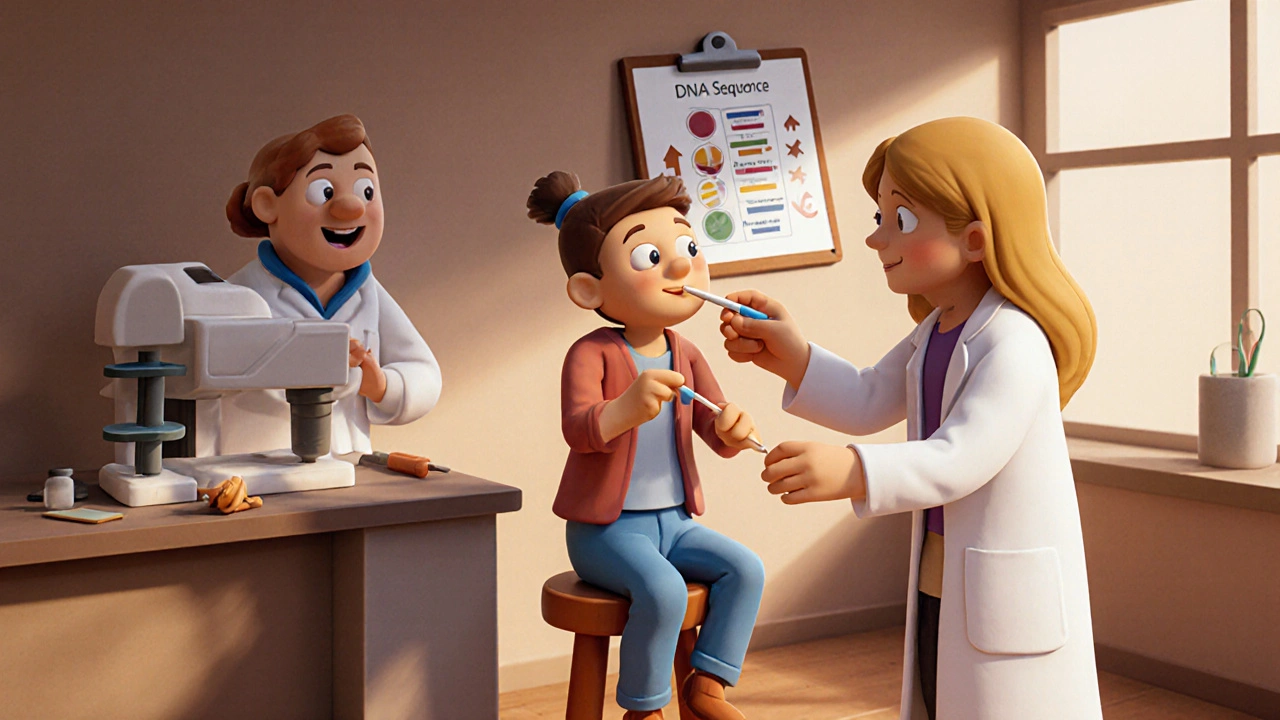SSRI Side Effect Risk Calculator
This tool helps you understand your potential risk of side effects from SSRIs based on your CYP2C19 and CYP2D6 metabolizer status. Select your phenotype for each enzyme to see how it affects your side effect risk and get personalized guidance.
Results will appear here after calculation
This tool is for educational purposes only. Always consult with a healthcare provider or certified pharmacogenetics pharmacist for personalized medical advice.
Imagine taking an antidepressant only to be hit with nausea, insomnia, or a pounding headache. For many, those side effects are a direct result of how their bodies process the drug. Pharmacogenomic testing looks at genetic variants that control drug metabolism, and for selective serotonin reuptake inhibitors (SSRIs) the most influential genes are CYP2C19 and CYP2D6. Understanding these variants can mean the difference between weeks of trial‑and‑error and a smoother, more tolerable treatment.
Why pharmacogenomic testing matters for SSRIs
SSRIs are prescribed to more than 20 million Americans each year, yet up to 50 % of patients experience adverse drug reactions (ADRs). The root cause often lies in the enzymes that break down the medication. When a patient carries a “poor metabolizer” version of CYP2D6, the drug lingers in the bloodstream, raising the chance of dizziness, nausea, or sexual dysfunction. Conversely, a “ultrarapid metabolizer” of CYP2C19 may clear the drug so fast that therapeutic levels are never reached, leaving depression untouched.
Key enzymes: CYP2C19 and CYP2D6 explained
The CYP2C19 enzyme processes citalopram, escitalopram, and sertraline, while CYP2D6 handles fluoxetine, paroxetine, venlafaxine, duloxetine, and several tricyclic antidepressants. Both genes are highly polymorphic: more than 100 alleles for CYP2D6 and about 35 for CYP2C19 have been catalogued. These alleles are combined into star (*) nomenclature (e.g., *1, *2, *17) that determines a patient’s metabolizer phenotype.
Metabolizer phenotypes and side‑effect risk
Phenotypes translate genotype into clinical action. Below is a quick reference that shows how each phenotype typically influences SSRI exposure and side‑effect likelihood.
| Enzyme | Phenotype | Typical plasma level change | Side‑effect trend |
|---|---|---|---|
| CYP2D6 | Poor Metabolizer (PM) | +200‑250 % | Higher risk of dizziness, nausea, insomnia |
| CYP2D6 | Intermediate Metabolizer (IM) | +50‑100 % | Moderately increased side‑effects |
| CYP2D6 | Normal Metabolizer (NM) | Baseline | Typical side‑effect profile |
| CYP2D6 | Ultrarapid Metabolizer (UM) | ‑50‑70 % | Reduced side‑effects but risk of sub‑therapeutic response |
| CYP2C19 | Poor Metabolizer (PM) | +200‑350 % | Significant increase in nausea, QT‑prolongation |
| CYP2C19 | Rapid Metabolizer (RM) | ‑30‑50 % | Fewer side‑effects, possible loss of efficacy |

How test results guide SSRI selection and dosing
The Clinical Pharmacogenetics Implementation Consortium (CPIC) released its most recent guideline in April 2023. The guideline provides concrete dose‑adjustment recommendations:
- Escitalopram: Reduce dose by 50 % for CYP2C19 PMs; consider alternative if the patient is also a CYP2D6 PM.
- Paroxetine: Avoid if CYP2D6 PM; use a lower starting dose for IMs.
- Venlafaxine: Start at half the usual dose for CYP2D6 PMs; monitor blood pressure closely.
- Sertraline: No formal CPIC dose change, but clinical reports suggest increased nausea in CYP2C19 PMs.
These recommendations are built on a 2022 meta‑analysis of 94 studies that linked genotype to plasma concentrations and side‑effect rates. While efficacy outcomes are mixed-especially for SSRIs-the consensus is that avoiding severe ADRs improves adherence, which indirectly supports better treatment response.
Evidence linking genotypes to side effects
Real‑world data reinforce the guidelines. A 2023 Frontiers in Pharmacology case series described a 45‑year‑old CYP2D6 PM who developed severe dizziness and insomnia on standard venlafaxine (75 mg/day). Halving the dose eliminated the side effects while preserving mood improvement. A separate study of 5,843 participants found CYP2D6 PMs were 3.2 times more likely to report “severe” side effects with paroxetine, and CYP2C19 PMs were 2.8 times more likely to experience nausea with citalopram.
However, not all research shows a clear clinical benefit. A large retrospective analysis of escitalopram response showed no significant association between CYP2C19 genotype and remission rates, despite a 2‑3‑fold difference in drug exposure. This discrepancy highlights that genotype is one piece of a larger puzzle that includes drug‑drug interactions, comorbidities, and psychosocial factors.

Practical steps to order and interpret tests
Here’s a quick workflow most clinics follow:
- Identify a patient who has failed two or more SSRI trials or reports intolerable side effects.
- Order a pharmacogenomic panel that includes CYP2C19 and CYP2D6. Preferred platforms are targeted genotyping arrays or next‑generation sequencing that can detect structural variants (important for CYP2D6).
- Collect a buccal swab or blood sample; typical turnaround is 1‑3 weeks.
- Review the report with a certified pharmacogenetics pharmacist. Use the CPIC dosing tables (available on the CPIC website) to adjust the current SSRI or switch to an alternative.
- Document the decision in the electronic health record and schedule a follow‑up within 2‑4 weeks to assess tolerability and therapeutic response.
Training for clinicians varies, but the American Psychiatric Association offers a 6‑hour CME module that covers interpretation basics. Many practices also rely on third‑party decision‑support tools that automatically flag high‑risk genotype‑drug pairs.
Insurance, cost, and implementation challenges
Cost is a common barrier. As of Q2 2024, only about 62 % of major U.S. insurers reimburse CYP2C19/CYP2D6 testing for depression. Out‑of‑pocket prices range from $150 to $350, depending on the lab and whether sequencing is used. To improve coverage, clinicians can submit a prior‑authorization request that cites CPIC Level A/B evidence and the potential to avoid $1,200‑$1,800 in trial‑and‑error prescribing costs per patient (Morris et al., 2022).
Another hurdle is interpreting complex reports when multiple genes are involved (e.g., CYP2B6, SLC6A4). Collaboration with a board‑certified pharmacogenetics pharmacist-of which there are roughly 1,200 in the U.S.-can streamline decision‑making and reduce misinterpretation risk.
Future outlook and research directions
The field is moving beyond single‑gene testing. The GUIDED‑2 pragmatic trial, launched in January 2024 with a $15.2 million NIH grant, is evaluating real‑world outcomes for 5,000 patients using a polygenic risk score that blends CYP2C19, CYP2D6, and other genetic markers. Early signals suggest that combining genotype with clinical variables (age, liver function, concurrent meds) improves prediction of both efficacy and side effects.
Regulatory bodies are also keeping pace. In March 2022, the FDA issued a safety communication reminding providers that pharmacogenomic results should complement-not replace-clinical judgment. Meanwhile, the Dutch Pharmacogenetics Working Group continues to publish alternative dose‑adjustment tables, prompting clinicians to consider local guidelines alongside CPIC.
By 2028, the global pharmacogenomics market is projected to hit $14.8 billion, with mental health applications accounting for roughly a fifth of that growth. As evidence accumulates and insurance coverage expands, it’s likely that pharmacogenomic testing becomes a routine step before prescribing any SSRI.
What is the difference between a CYP2C19 poor metabolizer and an ultrarapid metabolizer?
A poor metabolizer (PM) has two loss‑of‑function alleles, leading to very high drug levels and a higher chance of side effects. An ultrarapid metabolizer (UM) carries duplicated functional alleles, clearing the drug quickly and often requiring higher doses to achieve efficacy.
Do I need to test both CYP2C19 and CYP2D6 for every SSRI?
Testing both genes covers the majority of SSRIs. CYP2C19 primarily affects citalopram, escitalopram, and sertraline, while CYP2D6 influences fluoxetine, paroxetine, and venlafaxine. If you’re using an SSRI metabolized by only one of these enzymes, a single‑gene test may suffice.
How long does it take to get results back from a pharmacogenomic lab?
Most CLIA‑certified labs report results within 1‑3 weeks after receiving the sample. Some boutique labs offer rapid turnaround (as fast as 48 hours) for an extra fee.
Will my insurance cover the cost of the test?
Coverage varies. About 62 % of major U.S. insurers reimburse for depression‑related CYP2C19/CYP2D6 testing. It helps to provide the CPIC guideline citation and potential cost‑savings when requesting prior authorization.
Can pharmacogenomic testing predict whether an SSRI will work?
The evidence is stronger for predicting side effects than for guaranteed efficacy. Some studies show no clear link between genotype and remission, but avoiding adverse reactions often improves adherence, which can indirectly boost treatment success.

